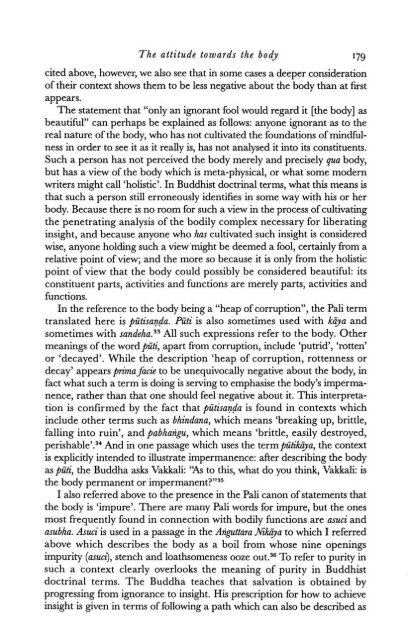Identity and Experience_Hamilton_1996
Identity and Experience_Hamilton_1996
Identity and Experience_Hamilton_1996
You also want an ePaper? Increase the reach of your titles
YUMPU automatically turns print PDFs into web optimized ePapers that Google loves.
The attitude towards the body<br />
cited above, however, we also see that in some cases a deeper consideration<br />
of their context shows them to be less negative about the body than at first<br />
appears.<br />
The statement that "only an ignorant fool would regard it [the body] as<br />
beautiful" can perhaps be explained as follows: anyone ignorant as to the<br />
real nature of the body, who has not cultivated the foundations of mindfulness<br />
in order to see it as it really is, has not analysed it into its constituents.<br />
Such a person has not perceived the body merely <strong>and</strong> precisely qua body,<br />
but has a view of the body which is meta-physical, or what some modern<br />
writers might call 'holistic'. In Buddhist doctrinal terms, what this means is<br />
that such a person still erroneously identifies in some way with his or her<br />
body. Because there is no room for such a view in the process of cultivating<br />
the penetrating analysis of the bodily complex necessary for liberating<br />
insight, <strong>and</strong> because anyone who has cultivated such insight is considered<br />
wise, anyone holding such a viewsrnight be deemed a fool, certainly from a<br />
relative point of view; <strong>and</strong> the more so because it is only from the holistic<br />
point of view that the body could possibly be considered beautiful: its<br />
constituent parts, activities <strong>and</strong> functions are merely parts, activities <strong>and</strong><br />
functions.<br />
In the reference to the body being a "heap of corruption", the Pali term<br />
translated here is piitis<strong>and</strong>a. Piiti is also sometimes used with kiiya <strong>and</strong><br />
sometimes with ~<strong>and</strong>eha.~~ All such expressions refer to the body. Other<br />
meanings of the word piiti, apart from corruption, include 'putrid', 'rotten'<br />
or 'decayed'. While the description 'heap of corruption, rottenness or<br />
decay' appears prima facie to be unequivocally negative about the body, in<br />
fact what such a term is doing is serving to emphasise the body's impermanence,<br />
rather than that one should feel negative about it. This interpretation<br />
is confirmed by the fact that piitis<strong>and</strong>a is found in contexts which<br />
include other terms such as bhindana, which means 'breaking up, brittle,<br />
falling into ruin', <strong>and</strong> pabharigu, which means 'brittle, easily destroyed,<br />
peri~hable'.~~ And in one passage which uses the term piitihya, the context<br />
is explicitly intended to illustrate impermanence: after describing the body<br />
as Piiti, the Buddha asks Vakkali: "As to this, what do you think, Vakkali: is<br />
the body permanent or im~ermanent?"~~<br />
I also referred above to the presence in the Pali canon of statements that<br />
the body is 'impure'. There are many Pali words for impure, but the ones<br />
most frequently found in connection with bodily functions are asuci <strong>and</strong><br />
asubha. Asuci is used in a passage in the Ariguttara Nikga to which I referred<br />
above which describes the body as a boil from whose nine openings<br />
impurity (usual, stench <strong>and</strong> loathsomeness ooze TO refer to purity in<br />
such a context clearly overlooks the meaning of purity in Buddhist<br />
doctrinal terms. The Buddha teaches that salvation is obtained by<br />
progressing from ignorance to insight. His prescription for how to achieve<br />
insight is given in terms of following a path which can also be described as<br />
I79


